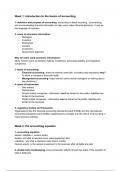Lecture notes
Introduction to the basics of accounting.
- Institution
- Cardiff University (CF)
This document is a comprehensive, structured guide ideal for anyone preparing to learn or teach the fundamentals of accounting. Designed across four weeks, it introduces essential concepts and practices, building a solid foundation for understanding how financial records are organized and interpret...
[Show more]



